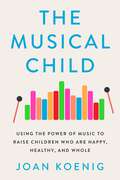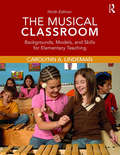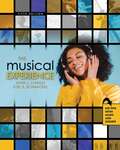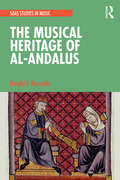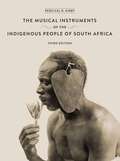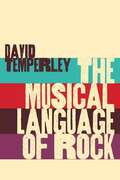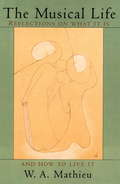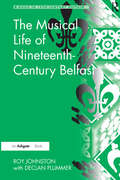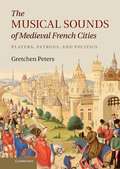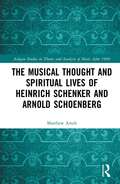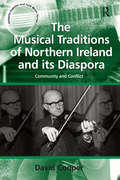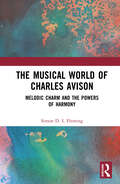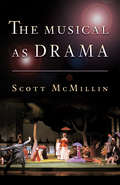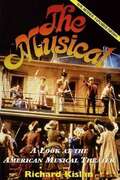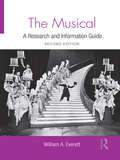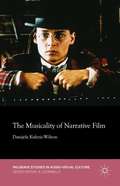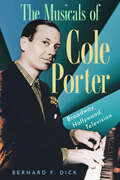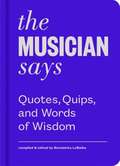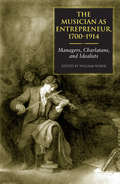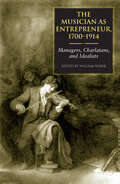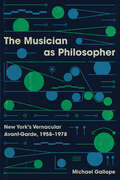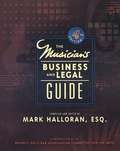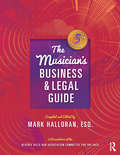- Table View
- List View
The Musical Child: Using the Power of Music to Raise Children Who Are Happy, Healthy, and Whole
by Joan Koenig&“Wonderful.&”—Herbie Hancock A pioneering music educator reveals how music can supercharge early childhood development—and how parents and educators can harness its power.Since opening her famed Parisian conservatory over three decades ago, Joan Koenig has led a global movement to improve children&’s lives and minds with the transformative power of music. With a curriculum and philosophy drawn from cutting-edge science, L&’Ecole Koenig has educated and empowered even its youngest students, from baby Max, whose coordination and communication grow as he wiggles and coos along to targeted songs and dance, to five-year-old Constance, who nourishes her empathy, creativity, and memory while practicing music from other cultures. In The Musical Child, Koenig shares stories from her classrooms, along with tips about how to use the latest research during the critical years when children are most sensitive to musical exposure—and most receptive to its benefits.A gift for parents, caregivers, musicians, and educators, The Musical Child reveals the multiple ways music can help children thrive—and how, in the twenty-first century, its practice is more vital than ever.
The Musical Classroom: Backgrounds, Models, and Skills for Elementary Teaching (9th Edition)
by Carolynn A. LindemanThe Musical Classroom: Backgrounds, Models, and Skills for Elementary Teaching, Ninth Edition, is designed for students majoring in elementary or music education. Through eight editions, this book has been a market leader in its field. Its goal has been to help teachers—some who may only have a limited background in music—prepare to make music a part of the daily lives of their students. The model lessons remain the centerpiece of the book's long-lasting success. Supported by a collection of children's songs from around the world, instructional information for learning to play basic instruments, and the theoretical, pedagogical, and practical backgrounds needed for reaching all learners, pre-service and in-service teachers can make their classrooms musical classrooms.
The Musical Experience
by John Chiego Joel S. SchnackelThe Musical Experience is a seamlessly integrated enhanced learning package that features a thematic approach to music appreciation - each theme is described along a historical timeline. Whether it is Music to Celebrate, Music from the Stage, or Music for Mourning, the reader will associate the music presented in The Musical Experience with a life moment - enhancing the experience! To resonate with today’s music appreciation students and instructors, John Chiego has updated The Musical Experience with contemporary examples of musical selections, musicals, and music from the movies since 2000. To meet the evolving needs of music appreciation students and instructors, John Chiego has integrated:: Features an easy-to-read conversational writing style that is suitable for students with diverse backgrounds and experience. Multiple delivery options! This complete course package with a print/eBook text and optional online music library and accompanying website supplements make it ideal for face-to-face, hybrid, and distance learning settings. Real-time assessments throughout! Biographical Spotlights, Listening Exercise questions, chapter question assignments, and What Makes Music features provide gradable components that can be completed by the reader on an ongoing basis throughout the semester. Includes Interactive Listening Charts that help readers with historical periods, genre, type of piece, and composer. Encourages self discovery! Students can access accompanying textbook playlists on the optional online music as well as create their own lists to expand their own listening library.
The Musical Heritage of Al-Andalus (SOAS Studies in Music)
by Dwight ReynoldsThe Musical Heritage of Al-Andalus is a critical account of the history of Andalusian music in Iberia from the Islamic conquest of 711 to the final expulsion of the Moriscos (Spanish Muslims converted to Christianity) in the early 17th century. This volume presents the documentation that has come down to us, accompanied by critical and detailed analyses of the sources written in Arabic, Old Catalan, Castilian, Hebrew, and Latin. It is also informed by research the author has conducted on modern Andalusian musical traditions in Morocco, Algeria, Tunisia, Egypt, Lebanon and Syria. While the cultural achievements of medieval Muslim Spain have been the topic of a large number of scholarly and popular publications in recent decades, what may arguably be its most enduring contribution – music – has been almost entirely neglected. The overarching purpose of this work is to elucidate as clearly as possible the many different types of musical interactions that took place in medieval Iberia and the complexity of the various borrowings, adaptations, hybridizations, and appropriations involved.
The Musical Instruments of the Indigenous People of South Africa
by Percival KirbyA detailed collection of information about the playing and making of the instruments of indigenous peoples' in South Africa. Percival Kirby was a musician and ethnomusicologist and for many years head of the music department at the University of the Witwatersrand, Johannesburg. Between 1923 and 1933 he undertook more than nine expeditions as well as many shorter excursions around South Africa. He was hosted by local chiefs and taught to play the instruments he encountered. He managed to purchase many of them, and this collection, now known as the Kirby Collection, is housed at the South African College of Music, University of Cape Town. First published as Musical Instruments of the Native Races of South Africa in 1934, the book was the culmination of research trips undertaken by Percival Kirby. It became the standard reference on indigenous South African musical instruments. The bulk of the material is concerned with detailed information on the making and playing of each instrument, and is accompanied by a large number of musical examples. This third edition contains an introduction by Mike Nixon, Head of the Ethnomusicology and African Music at the South African College of Music, and new reproductions of the valuable historic photographs, but leaves Kirby's original text unchanged.
The Musical Language Of Rock
by David TemperleyIn all of the books about rock music, relatively few focus on the purely musical dimensions of the style: dimensions of harmony and melody, tonality and scale, rhythm and meter, phrase structure and form, and emotional expression. The Musical Language of Rock puts forth a new, comprehensive theoretical framework for the study of rock music by addressing each of these aspects. Eastman music theorist and cognition researcher David Temperley brings together a conventional music-analytic approach with statistical corpus analysis to offer an innovative and insightful approach to the genre. With examples from across a broadly defined rock idiom encompassing everything from the Beatles to Deep Purple, Michael Jackson to Bonnie Raitt, The Musical Language of Rock shows how rock musicians exploit musical parameters to achieve aesthetic and expressive goals-for example, the manipulation of expectation and surprise, the communication of such oppositions as continuity/closure and tension/relaxation, and the expression of emotional states. A major innovation of the book is a three-dimensional model of musical expression-representing valence, energy, and tension-which proves to be a powerful tool for characterizing songs and also for tracing expressive shifts within them. The book includes many musical examples, with sound clips available on the book's website. The Musical Language of Rock presents new insights on the powerful musical mechanisms which have made rock a hallmark of our contemporary musical landscape.
The Musical Life
by W. A. MathieuEveryone, according to W.A. Mathieu, is musical by nature--it goes right along with being human. And if you don't believe it, this book will convince you. In a series of interrelated short essays, Mathieu takes the reader on a journey through ordinary experiences to open our ears to the rich variety of music that surrounds us but that we are trained to ignore; such as the variety of pitches produced by different objects, like glassware, furniture, drums--anything you can tap; or sounds that hover on the border of music, like laughter, the clinking of glasses in a toast, or the unintentional falsetto produced by yawning. Along the way the author teaches aspects of music theory that nonmusicians might ordinarily shy away from. He reveals the way of music to be a profoundly spiritual path--one that is everyone's birthright.
The Musical Life of Nineteenth-Century Belfast (Music In Nineteenth-century Britain Ser.)
by Roy JohnstonRoy Johnston and Declan Plummer provide a refreshing portrait of Belfast in the nineteenth century. Before his death Roy Johnston, had written a full draft, based on an impressive array of contemporary sources, with deep and detailed attention especially to contemporary newspapers. With the deft and sensitive contribution of Declan Plummer the finished book offers a telling view of Belfast‘s thriving musical life. Largely without the participation and example of local aristocracy, nobility and gentry, Belfast‘s musical society was formed largely by the townspeople themselves in the eighteenth century and by several instrumental and choral societies in the nineteenth century. As the town grew in size and developed an industrial character, its townspeople identified increasingly with the large industrial towns and cities of the British mainland. Efforts to place themselves on the principal touring circuit of the great nineteenth-century concert artists led them to build a concert hall not in emulation of Dublin but of the British industrial towns. Belfast audiences had experienced English opera in the eighteenth century, and in due course in the nineteenth century they found themselves receiving the touring opera companies, in theatres newly built to accommodate them. Through an energetic groundwork revision of contemporary sources, Johnston and Plummer reveal a picture of sustained vitality and development that justifies Belfast‘s prominent place the history of nineteenth-century musical culture in Ireland and more broadly in the British Isles.
The Musical Sounds of Medieval French Cities: Players, Patrons, and Politics
by Gretchen PetersDrawing upon hundreds of newly uncovered archival records, Gretchen Peters reconstructs the music of everyday life in over twenty cities in late medieval France. Through the comparative study of these cities' political and musical histories, the book establishes that the degree to which a city achieved civic authority and independence determined the nature and use of music within the urban setting. The world of urban minstrels beyond civic patronage is explored through the use of diverse records; their livelihood depended upon seeking out and securing a variety of engagements from confraternities to bathhouses. Minstrels engaged in complex professional relationships on a broad level, as with guilds and minstrel schools, and on an individual level, as with partnerships and apprenticeships. The study investigates how minstrels fared economically and socially, recognizing the diversity within this body of musicians in the Middle Ages from itinerant outcasts to wealthy and respected town musicians.
The Musical Thought and Spiritual Lives of Heinrich Schenker and Arnold Schoenberg (Ashgate Studies in Theory and Analysis of Music After 1900)
by Matthew ArndtThis book examines the origin, content, and development of the musical thought of Heinrich Schenker and Arnold Schoenberg. One of the premises is that Schenker’s and Schoenberg’s inner musical lives are inseparable from their inner spiritual lives. Curiously, Schenker and Schoenberg start out in much the same musical-spiritual place, yet musically they split while spiritually they grow closer. The reception of Schenker’s and Schoenberg’s work has sidestepped this paradox of commonality and conflict, instead choosing to universalize and amplify their conflict. Bringing to light a trove of unpublished material, Arndt argues that Schenker’s and Schoenberg’s conflict is a reflection of tensions within their musical and spiritual ideas. They share a particular conception of the tone as an ideal sound realized in the spiritual eye of the genius. The tensions inherent in this largely psychological and material notion of the tone and this largely metaphysical notion of the genius shape both their musical divergence on the logical (technical) level in theory and composition, including their advocacy of the Ursatz versus twelvetone composition, and their spiritual convergence, including their embrace of Judaism. These findings shed new light on the musical and philosophical worlds of Schenker and Schoenberg and on the profound artistic and spiritual questions with which they grapple.
The Musical Traditions of Northern Ireland and its Diaspora: Community and Conflict (Ashgate Popular And Folk Music Ser.)
by David CooperFor at least two centuries, and arguably much longer, Ireland has exerted an important influence on the development of the traditional, popular and art musics of other regions, and in particular those of Britain and the United States. During the past decade or so, the traditional musics of the so-called Celtic regions have become a focus of international interest. The phenomenal success of shows such as Riverdance (which appeared in 1995, spawned from a 1994 Eurovision Song Contest interval act) brought Irish music and dance to a global audience and played a part in the further commoditization of Irish culture, including traditional music. However, there has been until now, relatively little serious musicological study of the traditional music of Northern Ireland. Northern Ireland remains a divided community in which traditional culture, in all its manifestations, is widely understood as a marker of religious affiliation and ethnic identity. Since the outbreak of the most recent 'troubles' around 1968, the borders between the communities have often been marked by music. For example, many in the Catholic, nationalist community, regard the music of Orange flute bands and Lambeg drums as a source of intimidation. Equally, many in the Protestant community have distanced themselves from Irish music as coming from a different ethnic tradition, and some have rejected tunes, styles and even instruments because of their association with the Catholic community and the Irish Republic. Of course, during the same period many other Protestants and Catholics have continued to perform in an apolitical context and often together, what in earlier times would simply have been regarded as folk or country music. With the increasing espousal of a discrete Ulster Scots tradition since the signing of the Belfast (or 'Good Friday') Agreement in 1998, the characteristics of the traditional music performed in Northern Ireland, and the place of Protestant musicians within popular Irish cult
The Musical Work of Nadia Boulanger
by Jeanice BrooksNadia Boulanger - composer, critic, impresario and the most famous composition teacher of the twentieth century UO was also a performer of international repute. Her concerts and recordings with her vocal ensemble introduced audiences on both sides of the Atlantic to unfamiliar historical works and new compositions. This book considers how gender shaped the possibilities that marked Boulanger's performing career, tracing her meteoric rise as a conductor in the 1930s to origins in the classroom and the salon. Brooks investigates Boulanger's promotion of structurally motivated performance styles, showing how her ideas on performance of historical repertory and new music relate to her teaching of music analysis and music history. The book explores the way in which Boulanger's musical practice relied upon her understanding of the historically transcendent masterwork, in which musical form and meaning are ideally joined, and show how her ideas relate to broader currents in French aesthetics and culture. "
The Musical World of Charles Avison: Melodic Charm and the Powers of Harmony
by Simon D.I. FlemingThis book explores the works and influence of the eighteenth-century British composer Charles Avison. Although he spent most of his life in the northern town of Newcastle upon Tyne, Avison went on to have a marked impact on the musical life of Britain during the second half of the eighteenth century. His concertos become part of the national concert repertory, while his critical treatise, An Essay on Musical Expression, shaped debates about musical aesthetics. This book provides the first sustained examination of Avison’s musical works and compositional techniques, and it traces how his music not only drew on influences from European composers but also reworked them and in turn, influenced others. Considering Avison’s musical compositions, the circumstances around their composition and dissemination, and their place in music history, the author confronts preconceptions about the quality of Avison’s music, reveals new dimensions of his work as a composer, and demonstrates the enduring popularity and impact of his music. The author also draws on Avison’s writings to consider how closely he adheres to his own musical aesthetics. Reassessing Avison’s contribution to British music history, this study makes the case for understanding him as an important figure in the development and spread of musical styles across eighteenth-century England.
The Musical as Drama
by H. Scott McMillinDerived from the colorful traditions of vaudeville, burlesque, revue, and operetta, the musical has blossomed into America's most popular form of theater. Scott McMillin has developed a fresh aesthetic theory of this underrated art form, exploring the musical as a type of drama deserving the kind of critical and theoretical regard given to Chekhov or opera. Until recently, the musical has been considered either an "integrated" form of theater or an inferior sibling of opera. McMillin demonstrates that neither of these views is accurate, and that the musical holds true to the disjunctive and irreverent forms of popular entertainment from which it arose a century ago. Critics and composers have long held the musical to the standards applied to opera, asserting that each piece should work together to create a seamless drama. But McMillin argues that the musical is a different form of theater, requiring the suspension of the plot for song. The musical's success lies not in the smoothness of unity, but in the crackle of difference. While disparate, the dancing, music, dialogue, and songs combine to explore different aspects of the action and the characters. Discussing composers and writers such as Rodgers and Hammerstein, Stephen Sondheim, Kander and Ebb, Leonard Bernstein, and Jerome Kern, The Musical as Drama describes the continuity of this distinctively American dramatic genre, from the shows of the 1920s and 1930s to the musicals of today.
The Musical-Mathematical Mind
by Gabriel Pareyon Silvia Pina-Romero Octavio A. Agustín-Aquino Emilio Lluis-PueblaThis book presents a deep spectrum of musical, mathematical, physical, and philosophical perspectives that have emerged in this field at the intersection of music and mathematics. In particular the contributed chapters introduce advanced techniques and concepts from modern mathematics and physics, deriving from successes in domains such as Topos theory and physical string theory. The authors include many of the leading researchers in this domain, and the book will be of value to researchers working in computational music, particularly in the areas of counterpoint, gesture, and Topos theory.
The Musical: A Look at the American Musical Theater
by Richard KislanThis revised and expanded edition of Kislan's acclaimed study of America's musical theater includes a new section on “Recent Musical Theater: Issues and Problems.” “The ancient union of drama and song, known as musical theater, comes in many forms – vaudeville, burlesque, comic opera, minstrels, etc. The author reviews these and other highlights of American musicals ... with a fascinating background on the elements that contribute to the success of a Showboat.” – King Features • “Worth study by anyone who still thinks that the musical is a collection of songs.” – The Stage
The Musical: A Research and Information Guide (Routledge Music Bibliographies #94)
by William EverettThe musical, whether on stage or screen, is undoubtedly one of the most recognizable musical genres, yet one of the most perplexing. What are its defining features? How does it negotiate multiple socio-cultural-economic spaces? Is it a popular tradition? Is it a commercial enterprise? Is it a sophisticated cultural product and signifier? This research guide includes more than 1,400 annotated entries related to the genre as it appears on stage and screen. It includes reference works, monographs, articles, anthologies, and websites related to the musical. Separate sections are devoted to sub-genres (such as operetta and megamusical), non-English language musical genres in the U.S., traditions outside the U.S., individual shows, creators, performers, and performance. The second edition reflects the notable increase in musical theater scholarship since 2000. In addition to printed materials, it includes multimedia and electronic resources.
The Musicality of Narrative Film
by Danijela Kulezic-WilsonFilm is often compared to music, explained by the use of musical terms and even conceived and structured using music as a model. The Musicality of Narrative Film is the first book to offer an in-depth examination of the film/music analogy through comparative analysis of both arts' common denominators: time, rhythm and movement. Drawing on a number of examples from contemporary art-house and mainstream cinema, Kulezic-Wilson argues that film's musical potential can be realized through various cinematic devices, with or without music. The book's final section contains detailed case studies of Darren Aronofsky's p, Jim Jarmusch's Dead Man and Joe Wright's Anna Karenina, which demonstrate how various factors contribute to achieving the effect of musicality in a large-scale form and how contrasting approaches to film time, rhythm and movement can create very different examples of film musicality.
The Musicals of Cole Porter: Broadway, Hollywood, Television
by Bernard F. DickCole Porter (1891–1964) remains one of America’s most popular composer-songwriters, known for the many urbane, witty, romantic songs he wrote for stage musicals and Hollywood films. Porter was unique among his contemporaries for writing both the music and lyrics for his compositions. To this day, several of his numbers—“Night and Day,” “I’ve Got You Under My Skin,” “You’re the Top,” and “I Get a Kick Out of You,” to name a few—endure as standards. In The Musicals of Cole Porter: Broadway, Hollywood, Television, Bernard F. Dick presents a critical study of Porter’s Broadway and movie musicals, and his one foray into live television, Aladdin—covering the period from his first failure, See America First (1916), to the moderately successful Silk Stockings (1955), which ended his Broadway career. Taking a chronological approach, interspersed with chapters on Porter’s “list songs” that owe much to such operas as Mozart’s Don Giovanni and Rossini’s The Barber of Seville; his love songs, often bittersweet and bleakly poignant; and, above all, his love of figurative language, Dick discusses in detail the various literary sources and cultural reference points that inspired the lyrics to Porter’s numbers. The first volume of its kind exclusively dedicated to exploring the extensive body of work by this influential twentieth-century songwriter, The Musicals of Cole Porter is a compelling resource for readers interested in the craft of a great composer-lyricist.
The Musician Says
by Benedetta LobalboThe Musician Says is an all-access backstage pass to the world of singers, songwriters, composers, and instrumentalists--all those who have a relationship with the Muse and have experienced the sacrifices, satisfactions, and frustrations it brings. You'll hear from an eclectic group that spans centuries and genres, from Mozart to Mick Jagger, Louis Armstrong to Jay Z, Dolly Parton to Lady Gaga, and many more. Paired like unlikely guests at a backstage party, this unruly crew riffs about the blessings and curses of the musician's life. This collection of intriguing and provocative quotations will remind anyone who has dreamed of playing Carnegie Hall (or maybe just mastering three chords) that the creative process bridges time and place, and that music is indeed a universal language.
The Musician as Entrepreneur, 1700-1914: Managers, Charlatans, and Idealists
by William WeberTo be successful, a musician often has to be an entrepreneur: someone who starts a performing venue, develops patrons, and promotes the project aggressively. Accomplishing this requires musicians to acquire social and business skills and to be highly opportunistic in what they do. In The Musician as Entrepreneur, 1700–1914, international scholars investigate cases of musical entrepreneurship between around 1700 and 1914 in Britain, France, Germany, and the United States. By uncovering the ways in which musicians such as Telemann, Beethoven, Paganini, and Liszt conducted their daily business, the authors reveal how musicians reshaped the frameworks of musical culture and, in the process, the nature of the music itself.
The Musician as Entrepreneur, 1700–1914: Managers, Charlatans, and Idealists
by William Weber“Marries scholarly discipline with intriguing reading . . . The book will satisfy the thirst of historians, musicians and perhaps even an economist or two.” —American Music TeacherTo be successful, a musician often has to be an entrepreneur: someone who starts a performing venue, develops patrons, and promotes the project aggressively. Accomplishing this requires musicians to acquire social and business skills and to be highly opportunistic in what they do. In The Musician as Entrepreneur, 1700–1914, international scholars investigate cases of musical entrepreneurship between around 1700 and 1914 in Britain, France, Germany, and the United States. By uncovering the ways in which musicians such as Telemann, Beethoven, Paganini, and Liszt conducted their daily business, the authors reveal how musicians reshaped the frameworks of musical culture and, in the process, the nature of the music itself.“Weber is an excellent music historian and the book will please all readers interested in musical sociology.” —Choice
The Musician as Philosopher: New York’s Vernacular Avant-Garde, 1958–1978
by Michael GallopeAn insightful look at how avant-garde musicians of the postwar period in New York explored the philosophical dimensions of music’s ineffability. The Musician as Philosopher explores the philosophical thought of avant-garde musicians in postwar New York: David Tudor, Ornette Coleman, the Velvet Underground, Alice Coltrane, Patti Smith, and Richard Hell. It contends that these musicians—all of whom are understudied and none of whom are traditionally taken to be composers—not only challenged the rules by which music is written and practiced but also confounded and reconfigured gendered and racialized expectations for what critics took to be legitimate forms of musical sound. From a broad historical perspective, their arresting music electrified a widely recognized social tendency of the 1960s: a simultaneous affirmation and crisis of the modern self.
The Musician's Business and Legal Guide
by Mark HalloranWritten specifically for musicians by legal and business experts in the music industry, this text covers nearly all of the confusing business and legal situations musicians find themselves in on the way to and through a professional career. It focuses on issues as they are actually practised with clause-by-clause commentaries on almost all the major music industry contracts.
The Musician's Business and Legal Guide, Fifth Edition
by Mark HalloranThe Musician’s Business and Legal Guide provides vital information to help demystify the music business and the complex body of law that shapes it. This book answers such questions as how to protect name and copyright; what is and is not legal about sampling; what are the legal issues surrounding digital downloads and streaming; what are the jobs of managers, talent agents and publishers; what are common contractual relationship between independent and major labels. The new edition includes chapters not covered in depth by other books: social media law, TV talent shows, YouTube, and international copyright. As in previous editions, the book features clause-by-clause contract analyses for 360 record deals, music publishing, management, and producer agreements.
